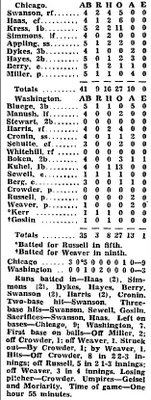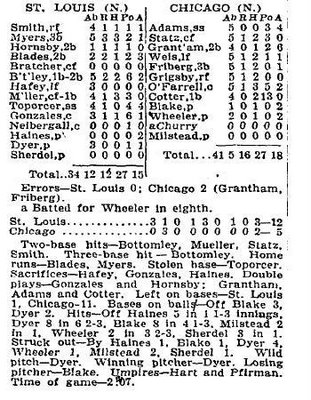Left-handers who played 2B, post-1920 (Updated)
| 1. Anthony Rizzo, Chicago Cubs, September 28, 2016; April 16, 2017; and April 17, 2017. Rizzo, normally the first baseman, was playing in to protect against the bunt with a runner on 1st and the pitcher up, while normal second baseman Ben Zobrist was holding the runner on at the first base bag. Pirates manager Clint Hurdle protested to the umpires that Zobrist was now the first baseman, making Rizzo's mitt illegal (see George Crowe, #5 below). The umpires agreed, forcing Rizzo to change to a normal lefty glove and Zobrist to a righty first baseman's mitt. After a sacrifice bunt, Rizzo and Zobrist got their old mitts/gloves back and returned to their usual positions. More details here. The Cubs continued to do the same in 2017. 2. Don Mattingly, New York Yankees, August 18, 1983. The classic Pine Tar game of July 24 was resumed 25 days later with 2 outs in the top of the 9th. The Yankees were without that game's starting 2nd baseman, Bert Campaneris, who had been placed on the disabled list on August 5. (Pitcher Ron Guidry replaced starting center fielder Jerry Mumphrey, who had been traded to Houston the previous week.) Campaneris was due up 1st in the bottom of the 9th, so manager Billy Martin replaced him with his best available offensive player, rookie Don Mattingly, batting .329. After a Hal McRae strikeout ended the Royals 9th, Mattingly flew out to center to lead off the bottom of the 9th. 3. Gonzalo Marquez, Oakland A's, May 4 and May 5, 1973. Marquez never actually played an inning at 2nd base. Oakland manager Dick Williams was dissatisfied with the offensive performance of his regular 2nd basemen, and would pinch-hit for them whenever they came to the plate. On both May 4 and 5, road games at Cleveland, Marquez, normally a 1st baseman, was listed at 2nd base and batted 2nd in the order, batted in the top of the 1st inning, and then replaced in the field by Dick Green. 4. Sam McDowell, Cleveland Indians, July 6, 1970. McDowell, a left-handed pitcher, had struck out 12 Washington Senators and was leading 6-4, but faced a second-and-third, 2 out jam in the 8th, with powerful righties Frank Howard and Rick Reichardt due to bat. Wanting a right-hander to pitch to Howard and Reichardt, but not wanting to lose McDowell for the rest of the game, Cleveland manager Alvin Dark shifted 2nd baseman Eddie Leon to 3rd base, moved McDowell to 2nd base, and brought in Dean Chance to pitch. After an intentional walk to Howard, Reichardt grounded to third, where Leon fielded the ball and threw to McDowell at 2nd for the force out. The strategy would pay off, as McDowell struck out the side in the 9th. 5. George Crowe, Cincinnati Reds, June 14, 1958. Crowe, the starting 1st baseman, swapped positions with 2nd baseman Johnny Temple with a runner on 1st, no outs, and pitcher John Briggs batting in the 2nd inning to defense against a possible bunt. Briggs hit into a double play, Crowe to Temple, and both fielders returned to their normal positions for the rest of the game. The Cubs protested, as Crowe used his normal first base mitt while playing 2nd base. Though the protest was denied (the Cubs won the game anyway), National League President Warren Giles ruled that first basemen moving to other positions had to switch to a normal glove. 6. Walter "Lefty" Stewart, Washington Senators, July 11, 1933.  Stewart, normally a starting pitcher, was a mere placeholder in the lineup for this game. Senators manager Joe Cronin originally planned to send out a right-handed-batting lineup, as the White Sox had warmed up a lefty, Walter Miller. But White Sox righty pitcher Joe Heving took batting practice, and Cronin saw the possibility that the White Sox might switch pitchers at the last minute, giving them the platoon advantage. To avoid wasting his righty batters, Cronin submitted a lineup with Stewart batting 3rd, playing 2B, and pitcher Earl Whitehill batting 6th, playing RF. Stewart and Whitehill took the field, but when the White Sox submitted a lineup with Miller pitching, both were pulled before a pitch was thrown. The strategy would have no effect; the White Sox took a quick 8-0 lead and won 9-3, with Miller pitching a complete game 8-hitter. Note: the New York Times box score does not list Stewart or Whitehill. 7. Jim Bottomley, St. Louis Cardinals, August 29, 1924.  Regular 2nd baseman Rogers Hornsby left the game with an injured back after the fourth inning. Ray Blades took his place at 2nd, but Blades was ejected after striking out in the top of the 9th. Center fielder Heinie Mueller moved to 1st base, and 1st baseman Bottomley moved to 2nd. 8. Edd Roush, Cincinnati Reds, October 3, 1920.  It was the last day of the regular season, and a meaningless game for both the Reds and Cardinals. The Reds had played a tripleheader (the third and last tripleheader in major league history) in Pittsburgh the day before. At some point in this 12-inning game, 4 Reds, including Roush, moved from their normal positions to ones they hadn't played all year. The Cincinnati Enquirer game report is unclear as to exactly when this happened; the article notes that Roth moved to 3B, Groh to SS, and Kopf to 2B when "the game was half over," which could mean the top of the 5th, 6th, or 7th. Kopf and Roush exchanged positions "the next inning," but moved back to their original positions "after the Card[inal]s had tied the score," which could mean at some point in the top of the 9th or to start the top of the 10th. |

Comments on "Left-handers who played 2B, post-1920 (Updated)"
post a comment